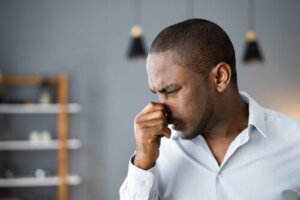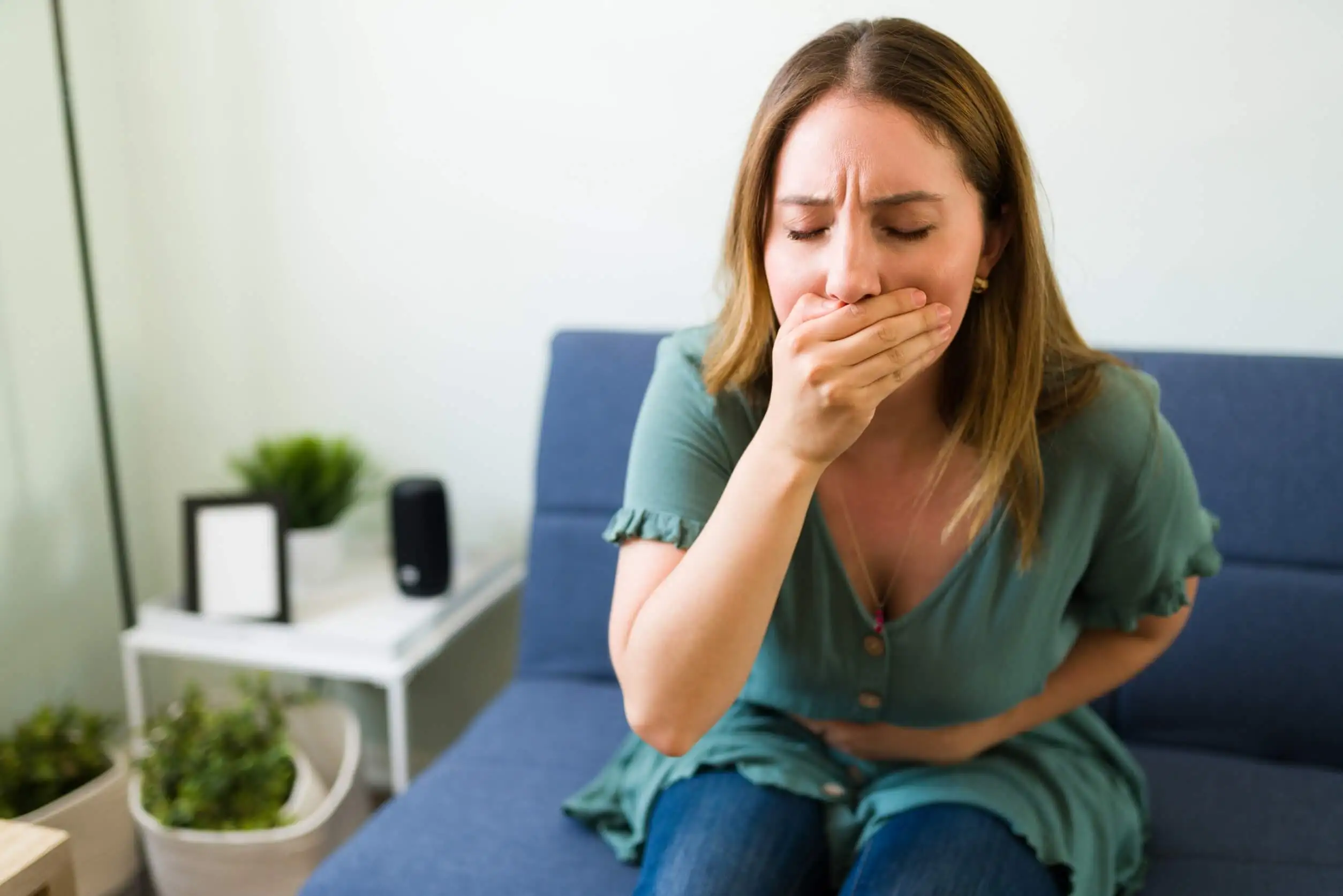What Is Parosmia?


Written and verified by the nutritionist Maria Patricia Pinero Corredor
Parosmia is a change in the normal perception of odors. It occurs when we smell something that’s familiar to us and that we usually like, but it actually becomes unpleasant to us.
There’s a distortion of the smells we used to like. It could transform the smell of coffee in the morning into a repulsive stench that leads to nausea.
Parosmia is on the list of the most common olfactory disorders, along with the following:
- Hyposmia: A reduced sense of smell.
- Anosmia: The inability to perceive odors.
- Phantosmia: Smelling something that isn’t really there.
Most of the time, the alteration of the sense of smell is accompanied by a taste disorder. And, recently, there have been greater repercussions due to its association with COVID-19, although coronavirus infection isn’t the only cause.
What happens in the brain of people with parosmia?
To understand a little more about this condition, it’s necessary to understand how the sense of smell works. The ability to smell begins in the olfactory sensory neurons, which are located in the upper inner part of the nose. From there, they connect the stimulus to the brain.
Each olfactory neuron has a receptor, which is stimulated by molecules released in the environment. The message reaches the brain and the odor is identified there. This identification involves subjective issues, such as memories. It’s different from the purely chemical identification that takes place, for example, in the food or perfume industry, as reported by the Universidad Veracruzana.
Now, what happens in a person with parosmia? The process isn’t entirely clear and depends on the underlying cause. However, experts agree on the assumption that there’s a partial loss of olfactory neurons, which causes an incomplete perception of smell.
A study published in the journal ENT showed how the brains of people with parosmia work differently compared to those who smell normally. This finding raised doubts about the peripheral origin of the problem. Perhaps, in some patients, the issue lies within the brain.
In favor of this hypothesis, a publication in The Laryngoscope showed that olfactory training helps to recover lost functions, so it would be feasible to create new “repair” neuronal connections.
In one way or another, the most usual symptom is always the unpleasant change in the perception of smells.
Smells that we liked are perceived as rotten or burnt. A rose or a flower may smell like feces. We may also think that what we’re cooking is burnt.
Find out more: Hyperosmia: Oversensitivity to Odors
Causes for parosmia
Currently, more than 100 causes for parosmia can be pointed out. Let’s discuss the most common ones, according to information from the U.S. National Institutes of Health:
- Smoking
- Nasal polyps
- Hormonal alterations
- Cranioencephalic traumas
- Radiation from cancer treatments
- Exposure to chemicals or medications
- Upper respiratory infections, such as sinusitis
- Disorders affecting the nervous system, such as Parkinson’s or Alzheimer’s disease

Parosmia caused by COVID-19
More recently, COVID-19 has joined the list of causes.
An analysis published in the journal Nature states that 47% of people with the disease have concomitant alterations of smell and taste. Of this percentage, 23% claim to have suffered from parosmia.
In the United Kingdom, a survey was carried out on patients who had overcome the disease 6 months earlier. The results revealed that 43% had lost their sense of smell and, on recovering it, suffered parosmia. This happened on average 2.5 months after discharge from COVID-19.
But what causes parosmia due to coronavirus? At first, it was thought to occur because the virus attacks olfactory neurons. However, studies on the subject revealed that this isn’t the case.
Olfactory neurons are linked by sustentacular cells, which contain a protein called ACE2. The virus attacks these cells because the protein acts as a code that allows SARS-CoV-2 to enter and damage them. This may also be the cause of the anosmia attributed to the coronavirus.
Upon infection and entry of the virus into the cells, via the ACE2 protein, scarring and attempts at repair by the tissues of the respiratory system begin. During this process, new and erroneous neuronal connections are made, which will eventually cause parosmia.
Read more: Is a Loss of Smell a Possible Coronavirus Symptom?
Is it treatable?
There’s no specific treatment to solve it. Actually, prescriptions are indicated according to what’s supposed to be the cause that gave rise to the problem.
A smoker will be instructed to stop smoking. If nasal polyps are present, they’ll be removed. Sinusitis will be treated with antibiotics.
The use of vitamins and minerals as supplements for treatment isn’t always effective. According to research, improvements are obtained if the person has a certified micronutrient deficit.
Impact of parosmia on daily life

Parosmia is a disorder that causes problems in people’s daily life. It prevents people from carrying out their normal routine and even attending social events.
Food may smell rotten, people may smell of sweat, even if they are clean, and disinfectants may be assimilated to feces. Even body odor itself can cause repulsion.
The sense of taste and smell are connected. So it’s common for patients to change their eating habits, as food becomes unpleasant because of its odor. Some people experience weight loss by not being able to stand the food and they reduce their daily calories.
Let’s remember that the sense of smell is a survival tool. It helps us to determine if we’re in danger. For example, in the event of a gas leak or distinguishing chemical products that could intoxicate us.
That’s why we shouldn’t let time pass if we think we have parosmia. We should consult an expert and start the appropriate tests to detect its origin.
All cited sources were thoroughly reviewed by our team to ensure their quality, reliability, currency, and validity. The bibliography of this article was considered reliable and of academic or scientific accuracy.
- Altundag, A. (2023). Parosmia and Phantosmia: Managing Quality Disorders. Current Otorhinolaryngology Reports, 11(1), 19-26. https://link.springer.com/article/10.1007/s40136-023-00441-w
- Brann, D. (2020). Non-neuronal expression of SARS-CoV-2 entry genes in the olfactory system suggests mechanisms underlying COVID-19-associated anosmia. Science Advances, 6(1), 31. https://advances.sciencemag.org/content/6/31/eabc5801.
- Hopkins, C. (2021). Prevalence and persistence of smell and taste dysfunction in COVID-19; how should dental practices apply diagnostic criteria? Nature, 34(1), 22–23. https://www.nature.com/articles/s41404-021-0652-4.
- Hopkins, C., Surda, P., Vaira, L. A., Lechien, J. R., Safarian, M., Saussez, S., Kumar, N. (2021). Six month follow-up of self-reported loss of smell during the COVID-19 pandemic. Rhinology, 59(1), 26-31. https://www.rhinologyjournal.com/Abstract.php?id=2727.
- Huamán, A., Aparcana, J. (2020). La anosmia como síntoma temprano en pacientes con COVID-19. Rev Fac Med, 20(3), 532-533. https://revistas.urp.edu.pe/index.php/RFMH/article/view/2949.
- Iannilli, E., Leopold, D. A., Hornung, D. E., & Hummel, T. (2019). Advances in understanding parosmia: an fMRI study. Orl, 81(4), 185-192. https://www.karger.com/Article/Abstract/500558
- Liu, D., Maha, M., Philpott, C., Oleszkiewicz, A., Hähner, A., Hummel, T. (2021). Parosmia is Associated with Relevant Olfactory Recovery After Olfactory Training. The Laryngoscope, 131(3), 618-623. https://doi.org/10.1002/lary.29277.
- National Institutes of Health (2013). Trastornos del olfato. Consultado el 30 de abril de 2023. https://www.nidcd.nih.gov/sites/default/files/Documents/health/spanish/smelldisorders-spanish.pdf.
- Parker, J. K., Kelly, C. E., & Gane, S. B. (2021). Molecular mechanism of parosmia. MedRxiv, 2021-02. https://www.medrxiv.org/content/10.1101/2021.02.05.21251085.abstract
This text is provided for informational purposes only and does not replace consultation with a professional. If in doubt, consult your specialist.








